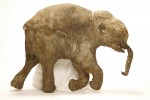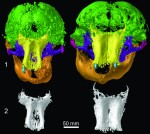 Much of what we know about woolly mammoths has come from discoveries of skeletal remains, and even when the occasional soft tissues were discovered, scientists weren’t able to examine thoroughly and non-invasively until the advent of technologies like computer tomography. The discovery of two baby mammoths preserved virtually intact for 40,000 years by the Siberian permafrost have given scientists a unique opportunity to learn about their lives and deaths using full-body CT scans and cutting edge X-ray technology.
Much of what we know about woolly mammoths has come from discoveries of skeletal remains, and even when the occasional soft tissues were discovered, scientists weren’t able to examine thoroughly and non-invasively until the advent of technologies like computer tomography. The discovery of two baby mammoths preserved virtually intact for 40,000 years by the Siberian permafrost have given scientists a unique opportunity to learn about their lives and deaths using full-body CT scans and cutting edge X-ray technology.
 Lyuba, who died when she was one month old, was found on the Yamal Peninsula in northwest Siberia in 2007. Khroma was two months old when she died in the northernmost area of Yakutia. She was discovered in 2009. They are the most complete examples of mammoths ever found, Khroma more so because her body was frozen almost immediately after death while Lyuba’s suffered some decomposition before it was stopped in its tracks by ice. Although they were found 3,000 miles apart, they are the same species and died around the same time which allowed for the first comparative study of mammoth skeletal development from two examples of known age.
Lyuba, who died when she was one month old, was found on the Yamal Peninsula in northwest Siberia in 2007. Khroma was two months old when she died in the northernmost area of Yakutia. She was discovered in 2009. They are the most complete examples of mammoths ever found, Khroma more so because her body was frozen almost immediately after death while Lyuba’s suffered some decomposition before it was stopped in its tracks by ice. Although they were found 3,000 miles apart, they are the same species and died around the same time which allowed for the first comparative study of mammoth skeletal development from two examples of known age.
Their completeness proved a challenge for researchers. Lyuba was too big to fit in standard CT scanners so at first scientists had to make do with partial scans done in Tokyo in 2009 and Wisconsin in early 2010. When the remains were transferred from Chicago to New Jersey later in 2010, University of Michigan researchers convinced the Russian team to let them take the mammoth on a detour to the Ford Motor Company’s Nondestructive Evaluation Laboratory in Detroit. They have an oversized scanner used to examine vehicle transmissions which was big enough to accommodate Lyuba. At Ford she got her first full-body scan.
 Researchers were then able to compare the Ford scans with ones taken of Khroma at two French hospitals, and compare Micro-CT scans of both mammoths’ teeth done at the University of Michigan School of Dentistry. It was the dental scans that pinpointed their ages at death — Lyuba was 30 to 35 days old, Khroma 52 to 57 days old — while the CT scans revealed interesting skeletal differences.
Researchers were then able to compare the Ford scans with ones taken of Khroma at two French hospitals, and compare Micro-CT scans of both mammoths’ teeth done at the University of Michigan School of Dentistry. It was the dental scans that pinpointed their ages at death — Lyuba was 30 to 35 days old, Khroma 52 to 57 days old — while the CT scans revealed interesting skeletal differences.
Scans of Khroma’s skull showed she had a brain slightly smaller than that of a newborn elephant, which hints at the possibility of a shorter gestation period for mammoths.
Lyuba’s skull is conspicuously narrower than Khroma’s, and her upper jawbones are more slender, while Khroma’s shoulder blades and foot bones are more developed. These differences may simply reflect the one-month age difference between the calves, or they could relate to the different populations from which the two calves derived.
The scans also found that the mammoths died in similar tragic accidents.
In Lyuba, the scans revealed a solid mass of fine-grained sediment blocking the air passages in the middle of the trunk. Sediment was also seen in Lyuba’s throat and bronchial passages. If Lyuba had died by drowning rather than suffocation – as some have suggested – then traces of sediment should also have been detected in parts of the lungs beyond the bronchial passages, but that was not the case.
Slightly coarser sediment was found in Khroma’s trunk, mouth and throat. Her lungs weren’t available for study because they were scavenged before the carcass was recovered. Since both animals appear to have been healthy at the time of death, a “traumatic demise” involving the inhalation of mud and suffocation appears to be the most likely cause of death in both cases, according to the authors.
The researchers suspect that Lyuba died in a lake because sediments found in her respiratory tract include fine-grained vivianite, a deep blue iron- and phosphate-bearing mineral that commonly forms in cold, oxygen-poor settings such as lake bottoms.
It’s possible that Lyuba crashed through the ice while crossing a lake during the spring melt. If she was struggling to breathe while submerged in a frigid lake, the mammalian “diving reflex” may have kicked in during her final moments, Fisher said. The reflex is triggered by cold water contacting the face, and it initiates physiological changes that enable animals to stay underwater for extended periods of time.
You can read the entire study, complete with 30 previously unpublished high resolution scan images, online free of charge in the Journal of Paleontology.